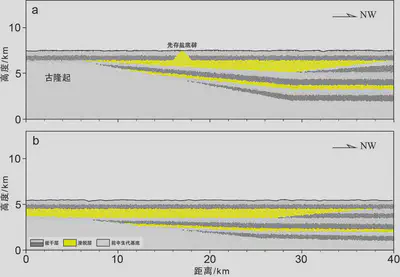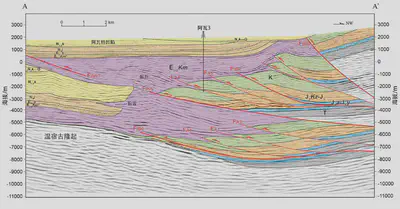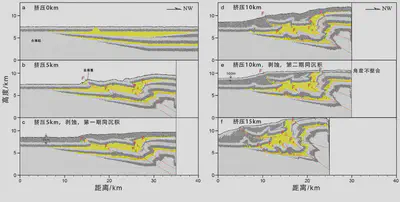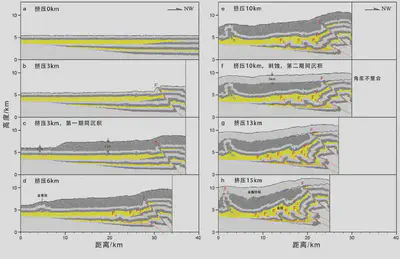Differential Structural Deformation and Numerical Simulation Analysis in the Awate-Boz Depression, Western Kuqa Depression (Geological Science)
Based on the latest three-dimensional seismic data and discrete element numerical simulation methods, this paper conducts detailed geological modeling of the area, simulates its formation and evolution process, and discusses the controlling factors of differential deformation(Xie et al.,2024)。
Title
Differential Structural Deformation and Numerical Simulation Analysis in the Awate-Boz Depression, Western Kuqa Depression
Authors
Huiwen Xie1,Long Chen2,3,Chao Wu1,Hanlin Chen2,3,Chenglong Gu1,Xiaogan Cheng2,3
- Tarim Oilfield Company, PetroChina
- School of Earth Sciences, Zhejiang University
- Research Center of Tectonics of Oil-Gas Bearing Basins, Ministry of Education
Abstract
The Awate-Boz area in the western Kuqa Depression is located in a structural compression-transfer zone, exhibiting significant differences in structural deformation along the strike. Based on the latest three-dimensional seismic data and discrete element numerical simulation methods, this paper conducts detailed geological modeling of the area, simulates its formation and evolution process, and discusses the controlling factors of differential deformation. In the Awate area, the subsalt strata are characterized by long-distance thrusting along the Keping Thrust Fault, forming two sets of superimposed thrust systems detached along the coal seams of the Jurassic; the suprasalt strata developed the relatively thin Awate Depression; salt structures are mainly unconformity-related. In the Boz area, the subsalt strata show high-angle basement-involved deformation north of the Keping Thrust Fault and detachment along coal seams to the south, forming an overall wedge-shaped imbricate thrust structure; the suprasalt strata developed the thick Baicheng Depression; salt structures are mainly conformity-related. Simulation results indicate that the Wensu Paleo-uplift limited the depositional extent of the Mesozoic to Paleogene strata and hindered the forward propagation of deformation, which is the most important reason for the differential deformation between the Awate and Boz areas. Preexisting salt diapir structures and the differential compression of the South Tianshan also have a certain controlling effect on the differential deformation in this area. The evolutionary process inferred from the integrated interpretation of seismic profiles and numerical simulation results shows that the tectonic activity in this area has a trend of increasing intensity, with structural deformation beginning during the deposition of the Jidike Formation in the early Middle Miocene and a significant tectonic acceleration event occurring after the deposition of the Kangcun Formation in the early Pliocene.

Fig. 4 Initial model design of Experiment 1 (a) and Experiment 2 (b)

Fig. 5 Interpretation scheme of Profile AA

Fig. 6 Interpretation scheme of Profile BB

Fig. 7 Interpretation scheme of Profile CC

Fig. 8 Simulation results and structural interpretation of Experiment 1

Fig. 9 Simulation results and structural interpretation of Experiment 2
Conclusions
Through detailed three-dimensional seismic interpretation, the structural deformation styles of the Awate and Boz areas in the western Kuqa Depression are clarified, and the similarities and differences between the two are compared. Using the discrete element numerical simulation method, the structural evolution processes of the two areas are simulated, and the controlling factors leading to their differential structural deformation are discussed. The main conclusions are as follows:
- The subsalt deformation in the Awate area is characterized by long-distance thrusting along the Keping Thrust Fault, forming two sets of superimposed detached thrust systems; salt structures are mainly unconformity-related salt pillows, salt tongues, and salt nappes; the suprasalt strata developed the relatively thin Awate Depression.
- The subsalt deformation in the Boz area is characterized by high-angle basement involvement north of the Keping Thrust Fault and detachment along coal seams to the south, forming an overall wedge-shaped imbricate thrust structure; salt structures are mainly conformity-related salt anticlines, salt pillows, and salt welds; the suprasalt strata developed the thick Baicheng Depression.
- The Wensu Paleo-uplift limited the depositional extent of the Mesozoic to Paleogene strata and hindered the forward propagation of deformation, which is the most important factor causing the differential deformation between the Awate and Boz areas. Preexisting salt diapir structures and the differential compression of the South Tianshan also play a certain controlling role in the differential deformation.
- The structural evolution process of the Awate and Boz areas is proposed: tectonic activity began during the deposition of the Jidike Formation in the early Middle Miocene, generally exhibiting a foreland-propagating expansion from the orogenic belt towards the basin interior, and a tectonic acceleration event occurred after the deposition of the Kangcun Formation in the early Pliocene, forming a regional angular unconformity.
Acknowledgements
The software used for the simulation experiments in this paper is the discrete element numerical simulation software VBOX (www.geovbox.com) developed by Dr. Li Changsheng, and we express our gratitude here.
Translator: Bao Xianjun